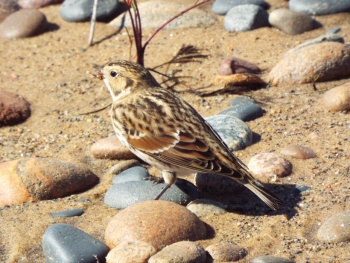(→External Links: Additional GSearch for common name, GSearch checked template) |
(→External Links: Multiple GSearches combined) |
||
| (One intermediate revision by the same user not shown) | |||
| Line 52: | Line 52: | ||
==External Links== | ==External Links== | ||
| − | + | {{GSearch|"Calcarius lapponicus" {{!}} "Lapland Longspur" {{!}} "Lapland Bunting"}} | |
| − | {{GSearch|Calcarius | + | {{GS-checked}}1 |
| − | |||
| − | |||
| − | {{ | ||
| − | {{GS-checked}} | ||
<br /> | <br /> | ||
<br /> | <br /> | ||
[[Category:Birds]][[Category:Calcarius]] [[Category:Bird Songs]] | [[Category:Birds]][[Category:Calcarius]] [[Category:Bird Songs]] | ||
Latest revision as of 00:12, 4 February 2023
Alternative name: Lapland Bunting
- Calcarius lapponicus
Identification
Length 15.6-17 cm (6¼-6¾ in), weight 23-35 g
- Thick yellow bill with dark tip
- Legs usually dark brown
- Black head and throat in summer male; orange-brown in female and winter male
- White eyestripe in summer male; buff in female and winter male
- Chestnut nape (duller in winter and juveniles)
- Greater coverts on wing chestnut with pale tips forming a chestnut panel and weak whitish wingbar
- White underparts
- Heavily streaked, brown-black-grey back
Distribution
Arctic Europe, Asia, and North America, breeding on tundra and wintering further south on coasts, steppes and open grassland, including stubble fields.
Taxonomy
Subspecies
This is a polytypic species consisting of 3 subspecies[1]:
- C. l. lapponicus:
- C. l. coloratus: Darker and slightly larger than nominate.
- Breeds far north-eastern Asia (Kamchatka and nearby areas).
- C. l. alascensis: Paler than nominate.
Habitat
Breeding
Wet areas with birch or willow, and or bare mountains.
Non-breeding
Open grassland or cultivated land or coasts; avoids shrubs and trees.
Behaviour
Diet
Includes insects when feeding young, and otherwise seeds.
Breeding
The nest is on the ground. The clutch consists of 2-4 eggs.
Vocalisation
The most common flight call is a hard prrrrt usually preceded by a more nasal teeww.
When breeding, it also makes a softer duyyeee followed by a pause and a triiiuuu; both sounds alternate.
References
- Del Hoyo, J, A Elliott, and D Christie, eds. 2011. Handbook of the Birds of the World. Volume 16: Tanagers to New World Blackbirds. Barcelona: Lynx Edicions. ISBN 978-8496553781
- Clements, J. F., T. S. Schulenberg, M. J. Iliff, D. Roberson, T. A. Fredericks, B. L. Sullivan, and C. L. Wood. 2016. The eBird/Clements checklist of birds of the world: v2016, with updates to August 2016. Downloaded from http://www.birds.cornell.edu/clementschecklist/download/
- Gill, F and D Donsker (Eds). 2014. IOC World Bird Names (version 4.3). Available at http://www.worldbirdnames.org/.
- Absolute Astronomy
Recommended Citation
- BirdForum Opus contributors. (2025) Lapland Longspur. In: BirdForum, the forum for wild birds and birding. Retrieved 10 May 2025 from https://www.birdforum.net/opus/Lapland_Longspur
External Links
GSearch checked for 2020 platform.1






